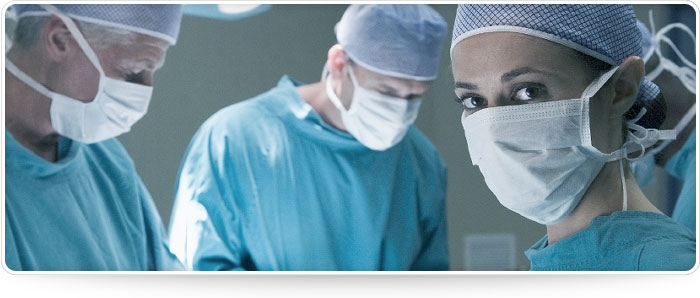 Anesthesia allows the realization of a safe surgical procedure or examination painful. It suppresses pain by preserving the balance of the body. There are several types of anesthesia offered by the state of health of the patient and the surgical procedure performed.
Anesthesia allows the realization of a safe surgical procedure or examination painful. It suppresses pain by preserving the balance of the body. There are several types of anesthesia offered by the state of health of the patient and the surgical procedure performed.
There are two main types of anesthesia:
General anesthesia :
You are completely asleep (e) using intravenous products and / or breathing vapor anesthetics.
The regional anesthesia :
Allows, for different technology, that numbs part of your body on which the operation will take place. Its principle is to block the nerves of this region, by injecting them near a local anesthetic. General anesthesia may be associated or become necessary, if insufficient anesthesia. Any anesthesia, general or locoregional, an act performed for non-urgent consultation requires several days in advance and a pre-anesthetic, the day before or hours before anesthesia under the terms of hospitalization.
The pre-anesthetic consultation :
The pre-anesthetic consultation carried out by an anesthesiologist is a legal obligation. A thorough medical examination to better know you, to reveal your past medical and surgical, whether you are taking medication.
No scientific or regulatory standard does the systematic use of additional tests. Only those motivated by the data of the interview, review of the Act and anesthesia are considered essential. If necessary, a specialist consultation is requested: electrocardiogram, chest radiograph, blood tests.
During the consultation you are invited (e) to ask any questions that you may have your information.
After this visit, a type of anesthesia, defined in terms of your health, the results of additional tests may be prescribed and the surgical procedure, you explained.
The final choice is the decision and the responsibility of the anesthesiologist who will practice anesthesia.
When blood is needed, the doctor will notify you.
Apart from life-threatening emergencies, the anesthesiologist may refuse to practice anesthesia.
Anesthesia can be performed in a minor without the written permission of parents, legal guardian, or person or entity who has received written authorization from parents.
The act anesthetic :
The day before or the morning of the procedure can be prescribed a premedication to calm your anxiety and prepare for anesthesia. You also need to stay sober.
Once you arrive in the operating room, a (e) Nurse (e) an anesthetist and anesthesiologist welcome you. The latter is not necessarily the one you met in pre-anesthetic consultation.However, the consultant took the precaution to send your case to his colleague who supports you.
Anesthesia, regardless of its type, takes place in a room with adequate equipment, suitable for you and checked before each use. All that is in contact with your body is either disposable or sterilized. The anesthesiologist and nurse anesthetist providing anesthesia and medical supervision throughout the intervention. They monitor the heart with a électrocardioscope and blood pressure, respiration and oxygenation of your blood.
The awakening :
At the end of the procedure, you will be taken (e) in a room of post-interventional to be monitored (e) continuously before returning to your room or leaving the facility. The time spent in the morning provides the best security possible after anesthesia and surgery.Monitoring is identical to that which is exercised during anesthesia. A nurse will assist you to provide appropriate care and relieve pain related to surgery. An anesthesiologist supervise this period.
When the anesthesiologist feels that you’re properly awake (e), you are escorted (s) in your room.
A prescription is transmitted to the nursing service to continue the treatments necessary for your health and relieve pain after surgery. During your hospital stay, the anesthesiologist is available to meet you if you wish.
What are the disadvantages and risks of anesthesia?
Any medical procedure, even necessary practice competently and in accordance with what is known by science, is always a risk.
The current conditions of anesthesia and monitoring of the period of awakening can quickly detect abnormalities and to treat them.
Nausea and vomiting have become rare with the new techniques and new drugs.
Accidents related to the passage of vomiting in the lungs if the instructions are exceptional young people are met.
The introduction of a tube into the trachea (intubation) or throat (laryngeal mask) to provide breathing during anesthesia can cause a few sore throat or hoarseness passengers.
Dental trauma are possible. This is why it is very important that you report any device or dental particular vulnerability.
Painful redness at the vein in which the products were injected can be observed. It disappears in a few days.
Prolonged standing on the operating table can cause nerve compression. In most cases, things are back to normal within days or weeks.
Anesthesia as an outpatient
RECOMMENDATIONS AT THE EXIT AFTER AMBULATORY ANESTHESIA
Undergoing anesthesia, so short and so light it is, your vigilance can be lowered without you remember. You are asked to take the medical and legal following the day of intervention in hospital outpatients (released the same day).
After an ambulatory anesthesia:
an hospitalization may be decided;
you can leave the clinic unless accompanied (e);
you can not leave alone (e), even by taxi;
do not drive;
do not use public transport for 24 hours;
Do not stay alone (e) the first night;
have a phone;
Rest is advisable;
take only prescribed treatments;
do not take any important responsibility;
you can eat and drink lightly in the evening of the review but did not consume alcohol.
Unforeseen complications with life-threatening are extremely rare. To give an order of magnitude, serious complications can occur only after several hundreds of thousands of anesthesia.



